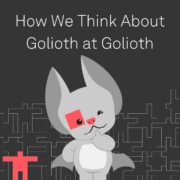How We Think About Golioth at Golioth
Last week, we announced our new pricing and “free device management” for individual developers. Golioth’s prices have outwardly changed, making our platform more accessible for a wide variety of use cases. Internally, however, the change is more impactful. We’ve created a new framework for our pricing that better aligns with how we think about Golioth as a product and the value we provide to our customers. “Device Management” often carries ambiguity in the industry, let’s clarify how we, at Golioth, define this category and it’s distinction from other areas of our IoT development platform. Here’s how we think about Golioth from a product perspective:
Golioth is broken up into three distinct product feature sets:
- Device Management
- Data Routing
- Application Services
These three categories make up what we call an “IoT development platform” here at Golioth.
Device Management
We think of device management as the category of features that every single IoT device on the planet needs. When I first joined Golioth, I called these “table stakes” features: Software Updates (OTA), Logging, Settings, Remote Procedure Calls, Credentials, and the ability to view your devices online/offline status in a UI. Now, all of us at Golioth, myself included call these “basic rights” of an IoT developer. These are features you simply cannot live without as an operator of a production fleet of IoT devices.
Data Routing
For constrained IoT applications that need to capture sensor readings and send them up to the cloud, it is often very challenging to securely and efficiently get that data to its end destination — whether that be a time series database, a visualization tool or your backend that powers a consumer facing app. This is where Golioth’s category of “data routing” features comes in: arbitrary data ingestion, transformation, and streaming of data to any cloud destination through “output streams”. You can think of data routing on Golioth as a “pipeline” from your devices to your final data destination. Something neat about using Golioth for data routing is that you can effectively “federate” to different databases or application backends with “no code”. This means you could migrate from one cloud to another, or one database to another without the need for a firmware update.
Application Services
Application services are the category of services we offer to make your life easier as an IoT developer. The goal here is to offset the development time and cost of building your own custom backend APIs, hosting your own database infrastructure, and ultimately shorten time to market for IoT products. LightDB Stream for example is a lightweight time series database for storing and querying sensor readings. You can use it to get up and running quickly, see and store live data flowing from your IoT sensors into Golioth and even build visualizations on top of it. But you don’t have to use it. For advanced IoT applications where you need hyper-scale performance and more control you may want to consider routing your data to InfluxDB, or MongoDB Time Series. Optionality is why we think of them as separate standalone services.
Finally, there is a fourth a category of features around collaboration, less so for devices and more so for the human users of Golioth. Any robust developer platform extends beyond just the technical capabilities—it needs to create an environment where team collaboration, API access, and efficient organizational and billing processes integrate seamlessly. We’ve designed Golioth to support everyone from individual developers to teams of any size, with scalability in mind from a single project to custom enterprise solutions that require private deployment models. These features don’t quite fit as neatly as the other 3 categories, but you’ll see them fall under the “Platform” section on our pricing page.
Hopefully this gives some insight into how we think about Golioth, at Golioth (and adds some clarity around the new pricing framework). We’re continuing to invest in all categories of our product — device management, data routing, application services and “platform” features. We look forward to sharing a few additional product announcements that we have cookin’ soon!
As always, let us know if there are any areas you want to see improved (or if you have questions about our new pricing) by reaching out to [email protected] or in our community forum.





Start the discussion at forum.golioth.io